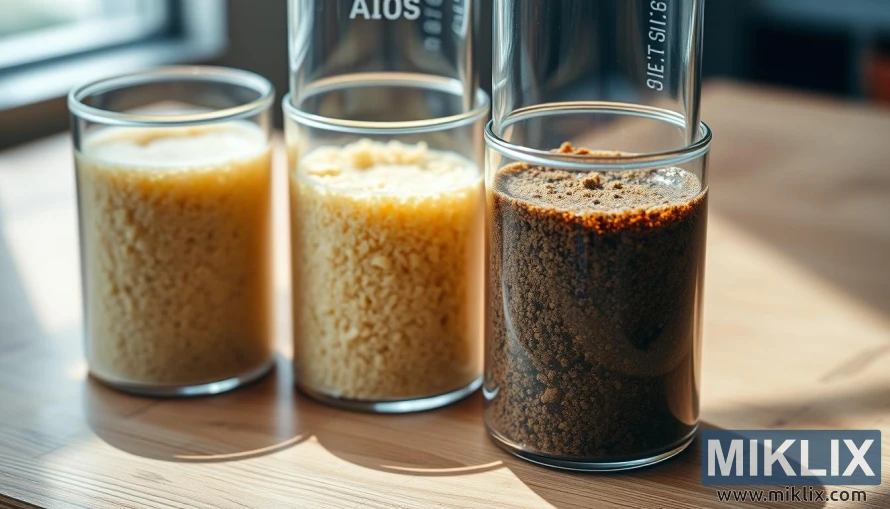Image: Comparing Ale Yeast Strains in Beakers
Published: July 21, 2025 at 2:53:22 PM UTC
Last updated: September 27, 2025 at 9:23:11 PM UTC
Close-up of four glass beakers with varying ale yeasts, showing colors, textures, and scientific comparison.
This image offers a quiet yet compelling glimpse into the nuanced world of fermentation science, where the smallest variations in texture, color, and composition can have profound effects on flavor, aroma, and brewing performance. Arranged neatly on a warm-toned wooden surface are three transparent glass containers, each filled with a distinct type of granulated or powdered substance. Though the image may at first appear simple, its composition and lighting elevate it into a study of contrast and detail, inviting the viewer to consider the subtle complexities of each sample.
The container on the left holds a pale yellow substance with a coarse, granular texture—reminiscent of couscous or small pasta grains. Its appearance suggests a dry yeast strain with larger particle size, possibly a strain selected for its robustness and ease of rehydration. The middle container features a slightly lighter yellow material, finer and more uniform in texture. This could represent a more refined or highly processed yeast variant, perhaps one optimized for rapid activation or consistent pitching rates. The third container, filled with a rich, dark brown substance, stands out dramatically against its lighter counterparts. Its finer granularity and deeper hue evoke associations with roasted malt or ground coffee, but in the context of yeast, it may indicate a strain with unique metabolic characteristics or one that has undergone a different drying or preservation process.
Each container is marked with volume measurements, reinforcing the scientific nature of the setup. These markings are subtle but essential, suggesting that the contents are not just for display but are part of a controlled experiment or comparative study. The wooden surface beneath the containers adds warmth and texture to the scene, grounding the sterile clarity of the glass in a more organic context. It evokes the tactile reality of brewing—the feel of grain, the scent of yeast, the ritual of preparation.
The lighting in the image is soft and natural, streaming in from the side and casting gentle shadows that accentuate the contours of the containers and the textures within. This illumination creates a sense of depth and dimensionality, allowing the viewer to appreciate the granularity and color variation of each sample. The shadows are not harsh; they are delicate, almost painterly, contributing to an atmosphere of calm focus and thoughtful observation.
Though the image lacks overt scientific instruments, its composition and clarity suggest a moment of inquiry—a pause in the brewing process where ingredients are examined, compared, and considered. It speaks to the brewer’s role not just as a technician but as a curator of flavor, someone who understands that the choice of yeast is as critical as the selection of hops or malt. Each strain carries its own personality, its own potential for transformation, and this image captures that diversity in a quiet, contemplative way.
Ultimately, the scene is a celebration of the unseen forces that shape the sensory experience of beer. It honors the yeast not just as a functional ingredient but as a living, responsive agent of change. Through its careful arrangement, natural lighting, and attention to detail, the image invites the viewer to look closer, to appreciate the beauty of fermentation at its most elemental, and to recognize the artistry embedded in even the most granular decisions of the brewing process.
The image is related to: Fermenting Beer with Lallemand LalBrew Nottingham Yeast

